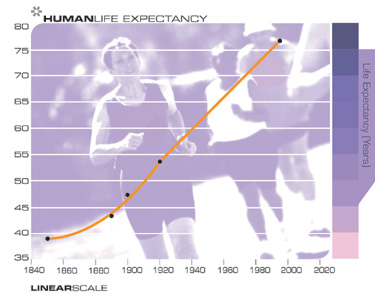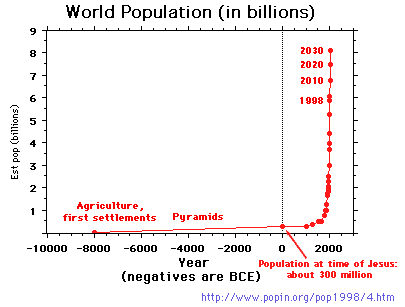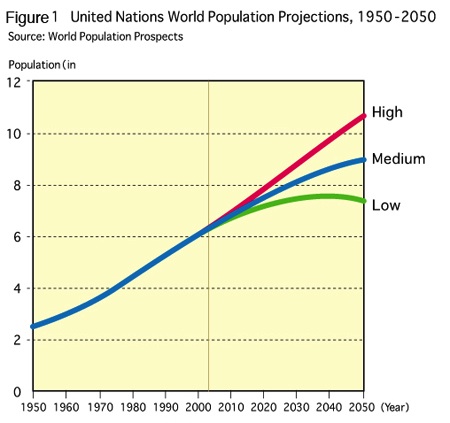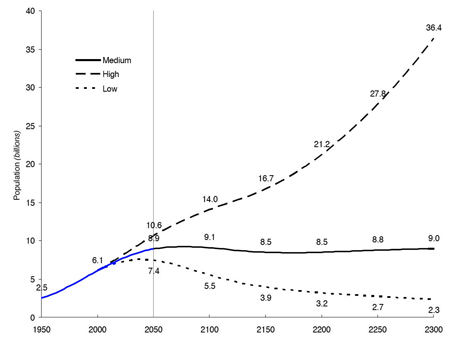The Origins of Progress
Every chart of technological progress zooms upward. Ray Kurzwiel has collected an entire gallery of graphs depicting the exponential upward trend in many, if not most, technological fields. All graphs of technological progress start low with small change several hundred years ago, and then begin to bend upwards in the last hundred, and then bolt upright to the sky in the last 50. A fairly typical chart would look like this one:

These charts capture a feeling we have that change is accelerating within our own lifetimes. Novelty arrives in a flash (compared to earlier), and there seems to be a shorter and shorter interval between novel changes. Further more, change in many areas seems to keep moving in one direction. Technologies get better and cheaper, faster and lighter, more common, easier and more powerful as we move into the future. And it is not just technology. The length of human lifespan increases, the rate of infant mortality decreases, and even average IQ inches forward every year.
If all this is true (and it may not be, but let’s accept its appearance for the moment), then what of long ago? Long ago there was not much evidence of progress at least how we now visualize it. Five hundred years ago technologies were not doubling in power and halving in price every 18 months. Waterwheels were not becoming cheaper every year. A hammer was not easier to use from one decade to next. Iron was not increasing in strength. The yield of corn seed varied by the season’s climate, instead of bettering each year. You could not upgrade your oxen’s yoke for anything much better than what you already had. And your own expected longevity, or your children’s, was whatever it was for your parents. Wars, famine, storms, and curious events came and went, but there was no steady movement in any direction. There was in short, change without progress.
Progress as a notion did not arrive until the 17th century or so, when it appeared in the West during the Enlightenment. Progress is a child of science and technology. It was born out of the observation that our inventions make life better. Sanitation made us healthier, Farm tools make more food for less work. Gadgets made our homes more comfortable. The more inventions, the better. There was a tight feedback loop as increased knowledge enabled us to discover and manufacture more tools, and these tools allowed us to discover and learn more knowledge, and both the tools and knowledge made our lives easier and longer. The general enlargement of knowledge and comfort and choices – and the sense of well-being – was called progress.
The rise of progress coincided with the rise of technology. But what pushed technology? We had thousands, if not tens of thousands of years of human culture, steadily learning, passing on information from one generation to the next – but no progress. Sure, new things would occasionally be discovered and slowly disseminated, or rediscovered independently, but whatever improvement one might measure over centuries in the old days would be very small. In fact the average farming peasant who lived in 1650 AD had a life that was nearly indistinguishable from the average farming peasant who lived in 1650 BC, or 3650 BC. In some valleys of the world in some particular times, the fate of citizens might rise above historical average, but only to descend when a dynasty ended, or the climate shifted. Before 300 years ago the standard of the average human’s life was fairly interchangeable anywhere in time or place: people were perennially hungry, short-lived, limited in choices, and extremely dependent on traditions simply to survive to the next generation. (They may have been just as happy and maybe even more content than us, but that is another story.)
For thousands of years this slow cycle of birth and death crept along when suddenly, boom! technology appears and everything starts moving very fast. What caused the boom in the first place? What is the origin of our progress?
There are several factors but chief among them is the invention of what we loosely call science. The ancient world accumulated many fabulous inventions such as arch bridges, aqueducts, iron plows, stirrups, steel, suspension bridges, watermills, paper, vegetable dyes, and so on. These innovations were distributed unevenly throughout the ancient world because each was discovered in a trial and error fashion, and the dissemination of their benefits was haphazard and unlikely. Geographical and cultural boundaries often prevented many innovations from spreading far. For instance, the Chinese independently invented most of the ancient technologies listed above centuries, and in some cases millennia, before Europeans did. Their use was either very parochial, culturally bound, or even sometimes deliberately restricted. But in all cases of ancient ingenuity in Asia, Europe, Africa and the Americas, each invention was discovered by the typical hit or miss process of tinkerers making small darwinian variations on something that worked and then using the variation themselves. Most of these changes made no difference, but the few that did improve performance took centuries to migrate elsewhere. There was no method for successful invention.
The invention that transformed this uneven haphazard accumulation of improvement was the tool of science. Science entails not only the canonical process of observation and experiment, but also the systematic accumulation of what worked and why. A large system of peer-review journals, science societies, and reference libraries was more essential to the uplifting influence of science than was the notion of a predictive hypothesis. By systematically recording the evidence for beliefs, and investigating the reasons for why things worked, and then carefully distributing proven innovations, science quickly became the best tool for making new things the world had ever seen. Science was in fact a superior method for a culture to learn. It beat the best trial and error approach of the past.
That was why the enlightened West zoomed past the vast lead in innovations that China had built up over centuries. China was the origin of most of the great discoveries up until the age of science. The Chinese culture had invented all these things via trial and error. But the one central invention the Chinese never made was the invention of science itself. Why China never invented science was the puzzle that obsessed the scholar Joseph Needham; if China could invent the most important inventions of all time, the compass, gunpowder and paper, why couldn’t they invent the scientific method as well? This conundrum eventually became known as Needham’s Question. While Needham proved China’s role in much of the world’s ancient inventions, he never came up with a good answer to his own question. For whatever complicated cultural reason, ingenious China never devised the system of knowledge improvement we know as science.
It’s really too bad they did not because science is sort of like the third wish for the magic lantern. It is the tool that invents new tools. Once you invent science – which allows you to quickly invent many things – you have your hand on a grand lever that can propel you forward very quickly. And that’s what happened in the West starting approximately in the 17th century. By the 18th century, science had launched the industrial revolution, and progress was noticeable in the growing spread of cities. As the contemporary charts of progress show, from there its rate kept accelerating over the years until it takes our breath away today.
But why was science invented in the Enlightenment? Why didn’t the Greeks invent it? Or the Egyptians? At first glance there seems to be no technological impediment for Egyptian (or Greek or Chinese) science. The necessary ingredients of the scientific method are conceptual and fairly low tech: A way to record, catalog and communicate written evidence, and the time to experiment. A time traveler from today could journey back to that era and set up the scientific method in ancient Alexandria or Athens without much trouble. But would it prosper?
Maybe not. Science is costly for an individual. Sharing results is a marginal benefit if you are chiefly seeking a better tool for today. The infrastructure costs of building a road or bridge are happily paid by individuals because the benefits of a road, bridge or aqueduct to an individual are immediate. The benefits of science are not apparent nor immediate for individuals. Science therefore requires more surplus and leisure in order to attain a sufficient number of individuals to join the collective and to willingly pay its costs of time and energy. Science may require a certain density of leisured population to thrive. That leisure is generated by pre-science inventions such as the plough, grain mills, domesticated power-animals, and other techniques which permit a steady surplus of food for large numbers of people. In Guns, Germs, and Steel Jared Diamond outlines a geographical theory for why Europe was the first to reach this threshold of surplus. Lucky Europe took thousands of years to slowly accumulate the necessary levels of technology needed to increase its population. Its early prosperity also enabled it to build the costly infrastructure of communication and wealth needed for inefficient experimentation and pursuit of abstract theories. While a well-fed population grew in number, the market and source for innovations also grew. Outside of the reign of science and technology a growing population will collapse as it meets Malthusian limits. But inside the reign of science a growing population creates a positive feedback loop wherein more people participate in scientific innovation and purchase the results, driving more innovation, and which births better nutrition, more surplus, more population, which feeds the cycle further.

In no time there is an exponential explosion of both people and progress. But this curious pairing of population and progress has not been examined very much. If we return to the charts of progress we find they fit almost exactly the curves of population. As population rises so does progress and vice versa. The two growths are heavily correlated, but correlated without causation.
We have many examples in modern times of increasing population suffering through declining living standards. That is happening in parts of Africa right now. On the other hand, throughout history we have very few examples of rising prosperity over the long term with declining population. Declining population is almost always associated with declining prosperity. Even during the decimations of the Black Plague, when 30% of an area’s population died, the change in living standards was uneven. Many of the overpopulated peasants in Europe and China prospered as their competition thinned out, but the quality of life for merchants and the upper class declined substantially. There was a redistribution of living standards, but not a net gain in new levels of progress during this time. From this evidence we might deduce that population growth is necessary but not sufficient for progress.
Clearly the roots of progress lie deep in the structured knowledge of science and technology. But the flowering of this progressive growth seems to also need the growth of large human populations. Historian Niall Ferguson believes that on the global scale, the origins of progress lie only in expanding population. By this framework in order to elevate populations beyond Malthusian limits you need science, but in the end, it is the increase in the number of humans that drives prosperity. More human minds invent more things and buy more inventions, including how to support more humans. More human minds equal more progress. The oft-reviled economist Julian Simon believed the same thing. He called human minds “the ultimate resource.” In his calculations, minds were the prime source of progress. The more the better.
Progress stems from the growth of human minds in two ways. It comes from the increase in number of minds and the increase in their collective structure and power. Science is a collective action. The solitary scientific genius is a myth. All the significant gains in science have come from integrating new knowledge into the deep wells of old knowledge. In fact the definition of a scientific discovery is not really “something we did not know before” but “something we did not know before that now is woven into everything we knew before.” Without that latter part, the new knowledge is esoteric and idiosyncratic, and not part of “what we know.” The rich botanical and medical knowledge of indigenous shamans will remain “undiscovered” until this knowledge can be linked into the entire corpus of existing knowledge. Once that new nonintegrated knowledge is connected to our other knowledge, we can say we know it as a scientific society. In this way science is both the way we know things and what we collectively know. It is performed by individuals, but it inhabits a culture. The greater the pool of individuals in the culture, the smarter science gets.
The economy works in similar way. Much of our current economic prosperity is due to growth. The population of the US has steadily grown over the past few centuries ensuring a steadily expanding market for innovations. At the same time world population has been expanding ensuring economic growth worldwide. That world population has also grown in accessibility and desire as billions moved from subsistence farming into the marketplace. But try to imagine the same rise of wealth and stock prices in the past two centuries if the world market or the US market shrank every year.
If it is true that progress expands as human population expands, then we should be worried. Everyone has seen the official graph of peak human population. The peak number of humans on Earth keeps changing (downward) but the shape of their history does not. It looks like this:

But I bet that you have not seen anywhere a chart which shows you the other side of the peak after the year 2050. After the population peaks what happens? Does it sink, swim or rise again? Why is that never shown? Most charts simply ignore the question. There is no apology for the blank spot. Showing just one half of the curve has been so common for so long that no one asks for the other half. Why does our forecast stop precisely at the peak in 2050? Why don’t we keep the forecast going? The only source I have found for a reliable projection of what happens on the other side of the peak of human population around 2050 is a set of UN scenarios for World Population in 2300, that is, for the next 300 years.

The high scenario assumes fertility rates remain at 1995 rates, or 2.35 children per woman. We already know this extreme version is not happening. The middle scenario assumes that the average fertility dips below replacement levels for 100 years and then for some reason returns to replacement level for the next 200 years. The low scenario assumes 1.85 children per woman. Today every country in Europe is below 2.0, and Japan is at 1.34.

Fertility rates in Europe. Dotted line is replacement level. (Source)
As countries become developed their fertility rate drops. This drop-off has happened for every modernizing country, and this universal decrease in fertility rates is known as the “demographic transition.” The problem is the demographic transition has no bottom. In developed countries the fertility rate keeps dropping. And dropping. Look at Europe (above) or Japan. Their fertility rate is headed to zero. In fact most countries, even developing countries, see their fertility rates dropping. Nearly half of the countries in the world are already under replacement level.
In other words, as prosperity increases due to expanding population, fertility rates drop, which will shrink population. This might be a homeostasis feedback mechanism that reins in exponential rates of progress. Or it might be wrong.
The UN 2300 scenarios are scary but the problem with the UN 300-year forecasts is that their dire scenario is not dire enough. The experts assume that even in the “worst-case scenario” fertility rates cannot go lower than the low rates found in places like Europe or Japan. Why do they assume this? Because it has never happened before. But of course this level of prosperity has never occurred before either. So far all evidence suggests that increased prosperity keeps lowering the number of children the average women wants. What if global fertility rates keep dropping below the replacement rate of 2.1 offspring for every woman in developed countries and 2.3 in developing countries? The replacement rate is what is needed to simply not decline, simply to maintain zero growth. To average 2.1 offspring means a significant portion of women have to have three, or four, or five babies in order to counter the childless and those with only one or two babies. What counter cultural force is at work prompting billions of modern, educated, working women to have 3, 4 or 5 babies? How many of your friends have four children? Or three? Just-a-few won’t matter in the long run.
Keep in mind that an enduring global fertility rate only a little below replacement level, say 1.9, will eventually, inevitably bring the world population to zero, because each year there are less and less babies. But long before human population drops to zero, the Amish and Mormons would save humankind with their prolific breeding and large families. Zeroing out is not the worry. The question is, if rising prosperity hinges on rising population, what happens to progress if there are centuries of slow population decline?
There are five scenarios:
1. The decline in world population halts at some manageable level, at a point where cultural forces encourage a steady replacement level of fertility. For instance, after the peak, the world population declines to 2 billion people with a fertility rate somewhere around 2.1. Perhaps technology makes having babies much easier, or much cheaper, though it is hard to imagine any way in which technology makes rearing three children any easier. Or perhaps there is social pressure to maintain the species, or social status in having a lot of children. Maybe robotic nannies change everything and having more than 2 kids becomes fashionable. It is not impossible to speculate on ways to maintain a status quo. But even if population leveled off, we don’t have any experience that a stagnant population produces rising progress.
2. While the census of human minds may decrease, we can build artificial minds, maybe even in the billions. Perhaps these artificial minds are all that is needed to keep prosperity expanding. To do so they would need to not only keep producing ideas, but also consuming them as well, just as humans do. Since they aren’t human (if you want a human mind make a baby) the prosperity and progress would likely look different from it is today.
3. Rather than expanding the number of human minds, maybe progress can keep increasing if the average human mind gets better, more powerful. Perhaps with the aid of always-on technologies, or genetic engineering, or pills, the potential of individual human minds increases, and this increase propels progress. Perhaps we increase our attention span, sleep less, live longer, and consume more, produce more, create more. The cycle spins faster with few more powerful minds.
4. We might have it all wrong. Maybe prosperity has nothing to do with increasing numbers of minds. Maybe consumption has no part in progress. We simply figure out how to increase living quality, choices, and possibilities with fewer and fewer people (who live longer and longer). It’s a very green vision, but also very alien to our current system. If every year there are less people as my potential audience, or my potential customers, I have to create things for a different reason than growth in audience or customers. A non-growth economy is hard to imagine. But stranger things have happened.
5. We plunge to small remnants, which in desperation breed madly and prosper. World population oscillates, up and down.
If the origins of prosperity lie solely in growth of human population, then it will paradoxically temper itself in the coming century. If the origins of progress lie outside of population growth, we’ll need to identify its source so that on the other side of the population peak, we can proceed to prosper.
I suspect, but cannot prove, the seeds of progress lie not in increasing numbers of human minds, or artificial minds, or more powerful individual minds, but in the emergence of a more complex group mind, made of fewer humans, many more machines, and a new way of thinking.


